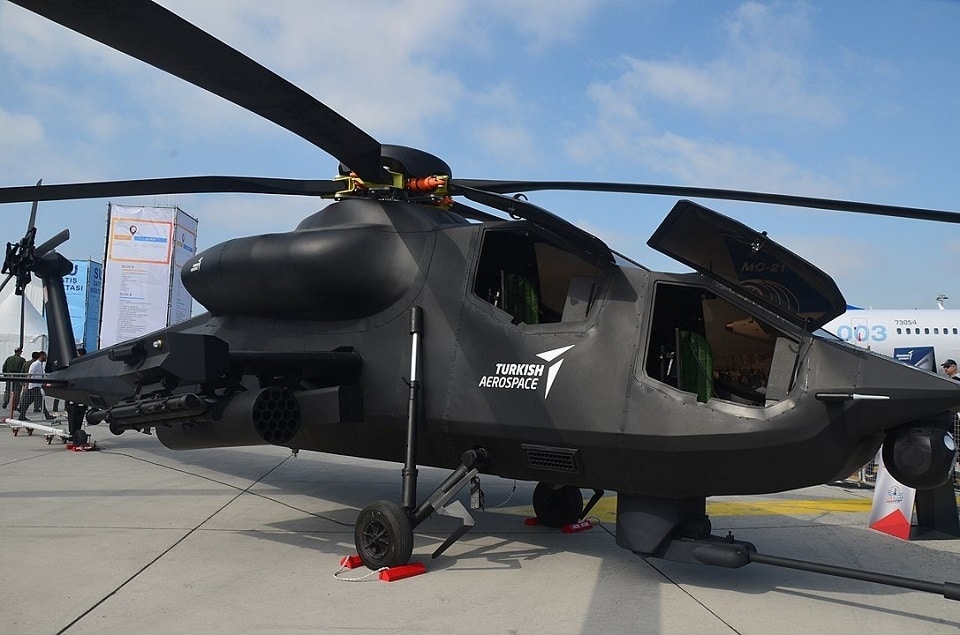Aerospace
Turkey unveils ATAK II helicopter with Ukrainian engines to compete with AH-64 Apache

Turkey recently unveiled the ATAK II helicopter, marking a significant advancement in the field of advanced military aircraft. This cutting-edge rotorcraft represents a formidable contender in the world of attack helicopters, poised to challenge the long-standing dominance of the renowned AH-64 Apache.
Turkey unveils new T929 heavy attack Helicopter(Opens in a new browser tab)
A strong competitor to the AH-64 Apache, the ATAK II has a number of advancements over its predecessor. It has an improved avionics system, a more potent engine, improved survivability features, and a longer mission range. The ATAK II can now operate successfully in a variety of combat situations, such as close air support, anti-armor missions, armed reconnaissance, and missions.
With a range of innovative features, enhanced capabilities, and state-of-the-art technology, the ATAK II is a testament to Turkey’s commitment to indigenous defense production and its ambition to secure a prominent position on the global military stage.
Comac launches freighter conversion programme for ARJ21(Opens in a new browser tab)
The ATAK II is an upgraded version of the original T-129 ATAK helicopter, which was jointly developed by the Turkish Aerospace Industries (TAI) and AgustaWestland (now Leonardo) of Italy. The original ATAK was itself an impressive attack helicopter, but the ATAK II aims to further enhance its combat capabilities and address any shortcomings identified through operational experience.
The ATAK II, which will make its maiden flight in the spring of 2023, is powered by two Ukrainian TV3-117 engines that have a combined output of 2500 hp. TAI and SBS are creating the ATAK II. A payload of 1500 kg is possible for the helicopter. 11,500 kg is the helicopter’s highest allowable takeoff weight.
For both Ukraine and Turkey, ATAK II is crucial. While the latter will attempt to gain market share on a worldwide scale, the former will be able to promote its propulsion systems. With a maximum take-off weight of 9,500 kg and 7,000 kg, respectively, the new helicopter is positioned as a rival to the AH-64 Apache.
A brand-new T929 attack helicopter also offers the first clear view of the nearly finished prototype. The rotorcraft, created under the ATAK-2 program and powered by Ukrainian-made engines, is anticipated to be handed to the Turkish Army starting in 2025, according to officials.
Chinese ‘flying car’ makes first public flight in Dubai(Opens in a new browser tab)
The cockpit has a big area display and can withstand ballistics up to 12.7 mm bullets. Six weapon stations, including freefall bombs, guided air-to-surface and air-to-air missiles, and guided and unguided rockets, are located on the stub wings, which can hold up to 1,200 kg of armaments. In addition, it has an Aselsan forward-looking electro-optic/infrared turret and a T-30H 30 mm chain cannon positioned on the chin.
This ATAK II helicopter could be a competitor to Apache and Russsian Ka-52 Kamov. The latest helicopter can be upgraded with advanced weaponry and avionics which is developed by Turkish aerospace and it will look forward for international customers for this helicopter Indonesia, Pakistan, and Egypt countries.

Aerospace
Boeing Transfers Rocket Stage to NASA, Paving Way for Human Moon Mission

Boeing has achieved a significant milestone by providing NASA with the second core stage of the Space Launch System (SLS) rocket.
This crucial component, crafted at NASA’s Michoud Assembly Facility (MAF), is set to propel the Artemis II crew into lunar orbit, marking humanity’s return to deep space after a 50-year hiatus.
The monumental Boeing-built rocket stage, the largest element of the Artemis II mission, will embark on a journey aboard the Pegasus barge, traveling 900 miles to NASA’s Kennedy Space Center.
Comparison of two legendary aircraft B777x vs B747 aircraft:Click here
Upon arrival, it will be meticulously integrated with other essential Artemis II components, including the upper stage, solid rocket boosters, and NASA’s Orion spacecraft within the iconic Vehicle Assembly Building. This intricate integration process is a vital step toward the eagerly anticipated Artemis II launch, slated for 2025.
“Boeing-built products helped land humankind on the moon in 1969, and we’re proud to continue that legacy through the Artemis generation,” remarked Dave Dutcher, vice president and program manager for Boeing’s SLS program. “Together, with NASA and our industry partners and suppliers, we are building the world’s most capable rocket and paving the way to deep space through America’s rocket factory in New Orleans.”
NASA, Lockheed Martin Reveal X-59 Quiet Supersonic Aircraft:Click here
The delivery of Core Stage 2 marks a significant achievement in the evolution of the SLS rocket. Towering over 200 feet and powered by four RS-25 engines, this core stage, coupled with two solid-fueled booster rockets, will generate a staggering 8.8 million pounds of thrust. This immense power is crucial to launching Artemis II and future missions into the vast expanse of space.
The SLS rocket stands unparalleled in its capability to transport both crew and substantial cargo to the moon and beyond in a single launch. Its extraordinary capacity will facilitate the delivery of human-rated spacecraft, habitats, and scientific missions to destinations including the moon and Mars, ushering in a new era of space exploration.
-

 Travel1 week ago
Travel1 week agoAir India to Expand US Operations with Three New Routes After a Decade
-

 Travel2 weeks ago
Travel2 weeks agoWhy We Should Avoid These Stamps in a Passport
-

 Airlines1 month ago
Airlines1 month agoInvestigations Reveal Fake Chinese Titanium in Boeing and Airbus Jets
-

 Tech4 weeks ago
Tech4 weeks agoChina’s CATL Plans 1,800-Mile Electric Plane Launch by 2027
-

 Airport3 days ago
Airport3 days agoTop 10 Largest Airports in the World by Size
-

 Aerospace4 weeks ago
Aerospace4 weeks agoChina’s Fighter Jets Turn Wings into Autonomous Drones
-

 Airlines4 days ago
Airlines4 days agoAir India Rolls Out A350s for Delhi-New York JFK and Newark Routes
-

 Defence3 weeks ago
Defence3 weeks agoBoeing Enhances Chinook with New Engines and Block II Upgrades at $96 Million







